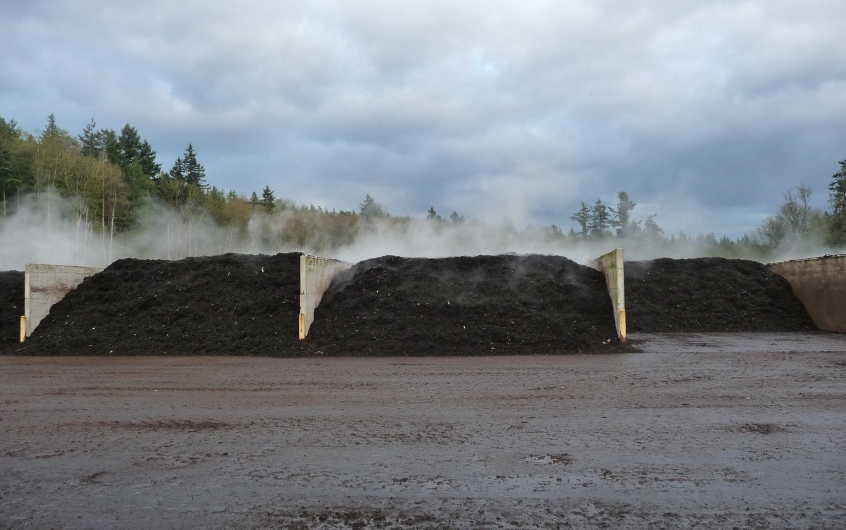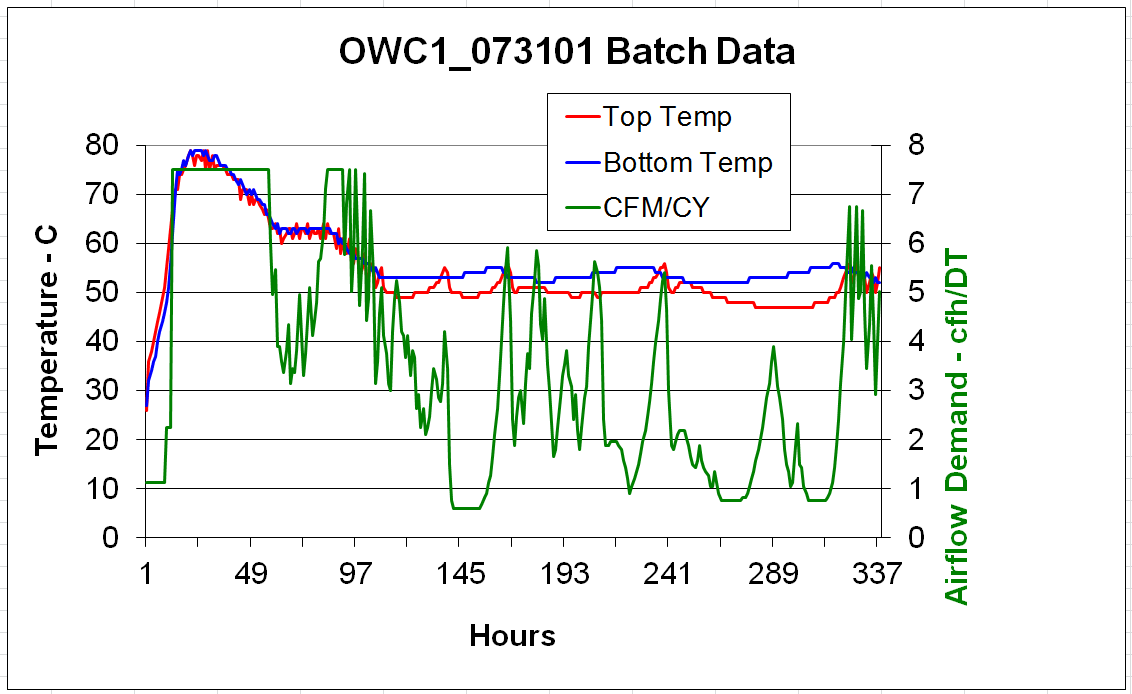
We have fielded this question from clients at both new facilities and at established facilities that have experienced a change in their operations. Generally the question stems from not being able to maintain PFRP (Processing for Further Reduction of Pathogen) temperatures (>55 for 72 hours), and occasionally from a biosolids composting facility that has to maintain time and temperature requirements to achieve Vector Attraction Reduction.
There are a lot of possible reasons for operators to give us this call. We start by asking to see their time/temperature and control output logs and for a clear explanation of how they build their piles and measure the temperatures. We also ask for the QC data on the temperature measurement system. (If you have one of our current web-enabled systems like the CompTroller™, we can access all this data on-line).
The composting process produces heat as a by-product of the bio-oxidation of organic carbon. It is primarily cooled through evaporation and to lesser extent by sensible heat transfer to the convective air and conductive heat transfer to the working surface and, in some cases, the walls (if in a bunker or vessel). Insulating and/or enclosing the piles serves to reduce these heat-loss paths. When a pile is not hitting or maintaining the required temperatures, it is because the heat production is not keeping up with the heat loss. So the problem can be attacked from either end, or from both.
To date our record high temperature in an aerated compost pile that we’ve measured was 91 C (yes, we checked to see that probe was calibrated). This was a very hot mix that included significant amounts of chicken litter, fresh ground wood, and had modest moisture levels. This, in fact, is way too hot for good composting, but PFRP temps were a non-issue. On the other hand we have clients trying to compost anaerobically digested cow manure; what carbon the cow couldn’t extract the AD did. Watching this material try to heat up is like watching paint dry. When comparing how much heat a mix can generate, the most significant characteristics are the amount of biologically available volatile solids (BVS) and the water content. A lot of BVS stokes the fire and lots of water blocks the Oxygen uptake and cools the pile like a swamp cooler in the summertime. So, when we encounter a dead mix, we often suggest sending samples of the initial mix to a good compost lab to get BVS and % solids data. We also suggest adding more energetic materials to the mix and reducing the initial moisture in small steps (say from 60% down to 58%). Small changes in moisture content in the 60-50% range make a big difference.
Many of our clients use forced aeration in primary composting, so the following will be of less use to the windrow/natural convection crowd. Our aeration systems generally use temperature as the primary feedback to modulate the amount of air being blown through the pile in an attempt to achieve an operator specified temperature goal. The simple theory is: the more air blown though the pile, the more evaporative cooling and the lower pile temperatures. This is always eventually true. Although with a hot mix it can take a week or more before there is enough fan power to start bringing the temperatures down from 10-20 degrees C over the set-point temperatures. But if that was your issue, you wouldn’t be reading this.
So being “aer-heads”, when we hear “cold pile” we immediately think about decreasing the evaporative cooling. The obvious first step is to decrease the amount of air going through the pile by changing the temperature, fan and/or damper settings in the control system if you have one, or manually if you don’t. The next step is to supply the pile with warmer, wetter air. We do this by recirculating exhaust air back into the supply air stream (we told you this part was not for windrow folks). The final rabbit we pull out of our hat is to apply reversing aeration. This alternates positive (upward) and negative (downward) aeration through the pile to automatically minimize the vertical temperature stratification in the pile. A side effect of this is less temperature change in the air passing through the pile and therefore less evaporative moisture transport (way nerdy, but thermodynamically true). So with all this in mind, we look at whatever settings we can adjust and make them. It turns out that we’ve managed to get some very dead wet mixes to achieve PFRP and VAR by playing all of these tricks, albeit slowly.

Using all these tricks at once can make for some very cool looking data as shown in the graph below. Note how the top and bottom temperature stay close together due to the reversing aeration. Also it’s interesting to note that the demand for cooling air (which is an analog for the rate of bio-oxidation = rate of composting) trends down, but varies very randomly, over time. This is why simple timer controlled fans are usually supplying either too much or too little air.
OK, what about those other heat loss paths? Well, there is nothing like a nice fully sealed and insulated in-vessel system to minimize extraneous heat loss. Too bad they only make economic sense for a select few facilities (make sure to call us if you think that might include you).
The most common insulation method is to apply a top layer of post PFRP overs or compost. Usually in a depth of 6 – 18 inches depending on conditions (Check out history of this in the classic EPA Beltsville Aerated Pile Method publication from 1980: http://cfpub.epa.gov/si/si_public_record_Report.cfm?dirEntryID=34511). Handling this additional material adds to OPEX, but it’s usually readily available.
The other method used is fabric pile covers – something we have many clients using.
This is a whole additional complicated topic (and raging controversy for the 14 people who care) that we’ll plunge into in another post. But suffice to say, covers can provide a partial barrier to evaporative cooling and only a very small amount of insulation to slow down conductive heat transfer. They are quite ineffective at providing meaningful insulation at the lower edges of the pile unlike a compost layer cover. But the final call on this topic is up to your LEA, and their temperature probes.
If you have any questions or issues that were not covered in this post, please contact us and we can discuss a customized solution for you.